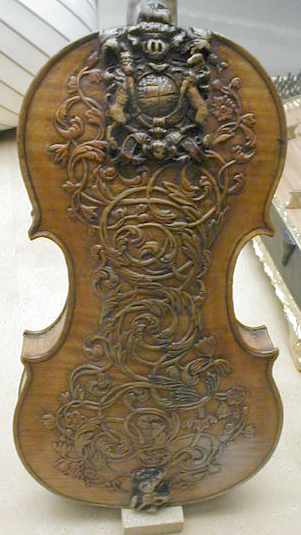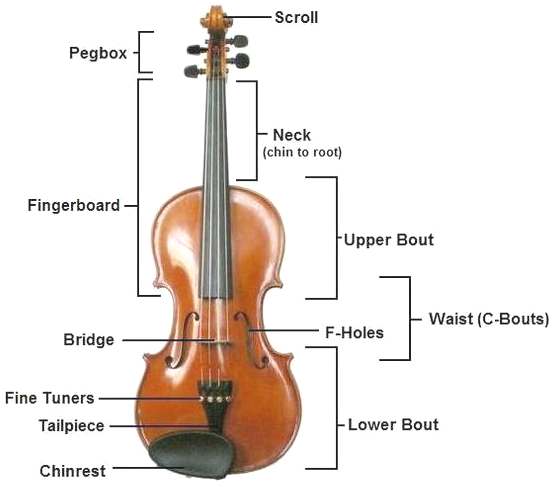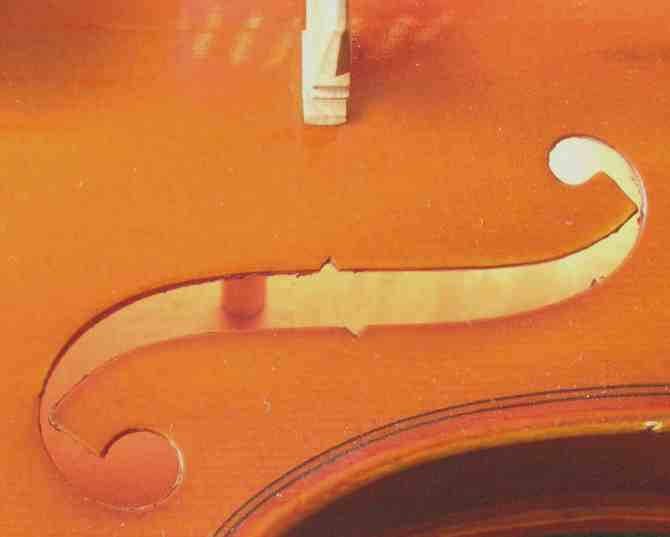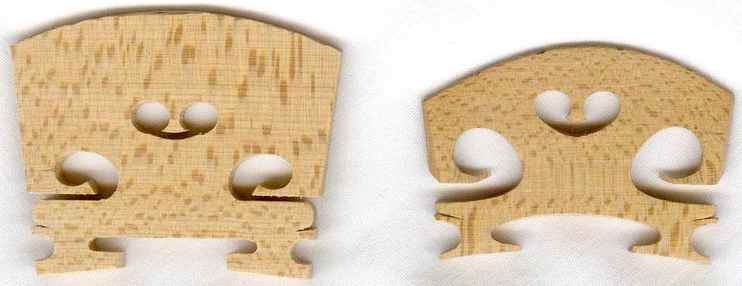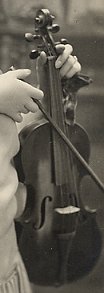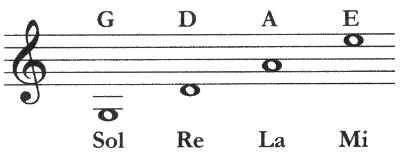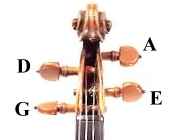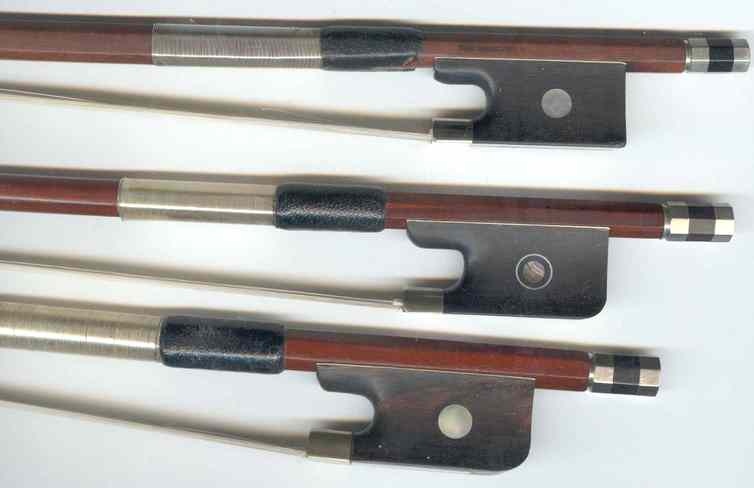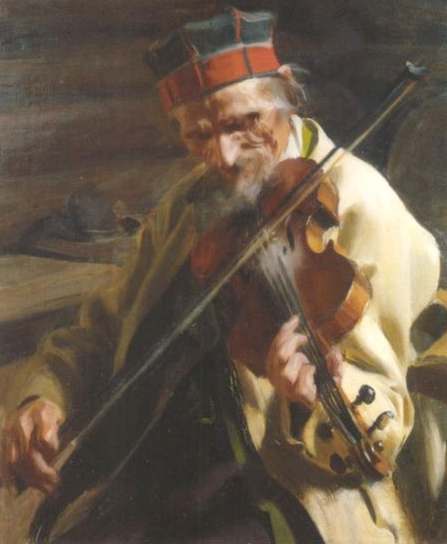|
VIOLIN
|
||||
|
HOME | BIOLOGY | FILMS | GEOGRAPHY | HISTORY | INDEX | INVESTORS | MUSIC | SOLAR BOATS | SPORT |
||||
|
The violin is a bowed string instrument with four strings tuned in perfect fifths. It is the smallest and highest-pitched member of the violin family of string instruments, which also includes the viola and cello.
A violin is sometimes informally called a fiddle, no matter what kind of music is played on it. The words "violin" and "fiddle" come from the Middle Latin word vitula, meaning "stringed instrument", but "violin" came through the Romance languages, meaning small viola, and "fiddle" through Germanic languages.
A person who plays violin is called a violinist or fiddler, and a person who makes or repairs them is called a luthier, or simply a violin maker.
Intricately carved 17th century (c. 1665) so called 'King James' by Ralph Agutter, British Royal Family violin, Victoria and Albert Museum, London
History of the violin
The violin emerged in northern Italy in the early 16th century. Most likely the first makers of violins borrowed from three types of current instruments: the rebec, in use since the 10th century (itself derived from the Arab rebab), the Renaissance fiddle, and the lira da braccio. One of the earliest explicit descriptions of the instrument, including its tuning, was in the Epitome musical by Jambe de Fer, published in Lyon in 1556. By this time the violin had already begun to spread throughout Europe.
The oldest documented violin to have four strings, like the modern violin, was constructed in 1555 by Andrea Amati. Other violins, documented significantly earlier, only had three strings. The violin immediately became very popular, both among street musicians and the nobility, illustrated by the fact that the French king Charles IX ordered Amati to construct 24 violins for him in 1560. The oldest surviving violin, dated inside, is from this set, and is known as the "Charles IX", made in Cremona c. 1560. "The Messiah" or "Le Messie" (also known as the "Salabue") made by Antonio Stradivari in 1716 remains pristine, never having been used. It is now located in the Ashmolean Museum of Oxford.
The most famous violin makers, called luthiers, between the late 16th century and the 18th century included:
Significant changes occurred in the construction of the violin in the 18th century, particularly in the length and angle of the neck, as well as a heavier bass bar. The majority of old instruments have undergone these modifications, and hence are in a significantly different state than when they left the hands of their makers, doubtless with differences in sound and response. But these instruments in their present condition set the standard for perfection in violin craftsmanship and sound, and violin makers all over the world try to come as close to this ideal as possible.
To this day, instruments from the "Golden Age" of violin making, especially those made by Stradivari and Guarneri del Gesù, are the most sought-after instruments by both collectors and performers.
The Construction of a Violin
Violin construction and mechanics
Construction
A violin typically consists of a spruce top, maple ribs and back, two endblocks, a neck, a bridge, a soundpost, four strings, and various fittings, optionally including a chinrest, which may attach directly over, or to the left of, the tailpiece. A distinctive feature of a violin body is its "hourglass" shape and the arching of its top and back. The hourglass shape comprises two upper bouts, two lower bouts, and two concave C-bouts at the "waist," providing clearance for the bow.
The "voice" of a violin depends on its shape, the wood it is made from, the "graduation" (the thickness profile) of both the top and back, and the varnish which coats its outside surface. The varnish and especially the wood continue to improve with age, making the fixed supply of old violins much sought-after.
All parts of the instrument which are glued together are done so using animal hide glue, a traditional strong water-based adhesive that is reversible, as glued joints can be disassembled if needed. Weaker, diluted glue is usually used to fasten the top to the ribs, and the nut to the fingerboard, since common repairs involve removing these parts.
The purfling running around the edge of the spruce top provides some protection against cracks originating at the edge. It also allows the top to flex more independently of the rib structure. Painted-on faux purfling on the top is a sign of an inferior instrument. The back and ribs are typically made of maple, most often with a matching striped figure, referred to as "flame", "fiddleback" or "tiger stripe" (technically called curly maple).
The neck is usually maple with a flamed figure compatible with that of the ribs and back. It carries the fingerboard, typically made of ebony, but often some other wood stained or painted black. Ebony is the preferred material because of its hardness, beauty, and superior resistance to wear. The maple neck alone is not strong enough to support the tension of the strings without bending, relying on its lamination with the fingerboard for strength. The shape of the neck and fingerboard affect how easily the violin may be played. Fingerboards are dressed to a particular transverse curve, and have a small lengthwise "scoop," or concavity, slightly more pronounced on the lower strings, especially when meant for gut or synthetic strings.
Some old violins (and some made to appear old) have a grafted scroll, evidenced by a glue joint between the pegbox and neck. Many authentic old instruments have had their necks reset to a slightly increased angle, and lengthened by about a centimeter. The neck graft allows the original scroll to be kept with a Baroque violin when bringing its neck into conformance with modern standards.
Sound post seen through f-hole
Bridge blank and finished bridge
The bridge is a precisely cut piece of maple that forms the lower anchor point of the vibrating length of the strings and transmits the vibration of the strings to the body of the instrument. Its top curve holds the strings at the proper height from the fingerboard in an arc, allowing each to be sounded separately by the bow. The sound post, or "soul post", fits precisely inside the instrument between the back and top, below the treble foot of the bridge, which it helps support. It also transmits vibrations between the top and the back of the instrument.
The tailpiece anchors the strings to the lower bout of the violin by means of the tailgut, which loops around the endpin, which fits into a tapered hole in the bottom block. Very often the E string will have a fine tuning lever worked by a small screw turned by the fingers. Fine tuners may also be applied to the other strings, especially on a student instrument, and are sometimes built in to the tailpiece.
At the scroll end, the strings wind around the tuning pegs in the pegbox. Strings usually have a colored "silk" wrapping at both ends, for identification and to provide friction against the pegs. The tapered pegs allow friction to be increased or decreased by the player applying appropriate pressure along the axis of the peg while turning it.
Violin and bow
Strings
Strings were first made of sheep gut, stretched, dried and twisted. Modern strings may be gut, solid steel, stranded steel, or various synthetic materials, wound with various metals. Most E strings are unwound and usually either plain steel or gold-plated.
Violinists carry replacement strings with their instruments to have one available in case a string breaks. Strings have a limited lifetime; apart from obvious things, such as the winding of a string coming undone from wear, a player will generally change a string when it no longer plays "true", with a negative effect on intonation, or when it loses the desired tone. The longevity of a string depends on how much and how intensely one plays. A violinist will generally change all four strings at once so they will age and stretch together.
Pitch range
The compass of the violin is from the G below the middle C to the highest register of the modern piano. The top notes, however, are often produced by natural or artificial harmonics, as placing fingers very close to the bridge on the highest string can often produce a very unpleasant and imprecise tone. Acoustics
The arched shape, the thickness of the wood, and its physical qualities govern the sound of a violin. Patterns of the nodes made by sand or glitter sprinkled on the plates with the plate vibrated at certain frequencies, called "Chladni patterns", are occasionally used by luthiers to verify their work before assembling the instrument.
Sizes
Children typically use smaller instruments than adults. Violins are made in so-called "fractional" sizes: 3/4, 1/2, 1/4, 1/8, 1/10, and 1/16; even 1/32-sized instruments exist. A 7/8 violin is sometimes used by an adult violinist of shorter stature as their final instrument, but rarely as a transitional instrument.
These fractional sizes have nothing to do with the actual dimensions of an instrument; in other words, a 3/4-sized instrument is not three-quarters the length of a full size instrument. The body length (not including the neck) of a "full-size" or 4/4 violin is about 14 inches (35 cm), smaller in some 17th century models. A 3/4 violin is 13 inches (33 cm), and a 1/2 size is 12 inches (30 cm). By comparison, when dealing with the violin's closest family member, the viola, size is specified as body length in inches rather than fractional sizes. A "full-size" viola averages 16 inches (40 cm).
The pitches of open strings on a violin
Scroll and pegbox, correctly strung
Tuning
Violins are tuned by turning the pegs in the pegbox under the scroll, or by adjusting the fine tuner screws at the tailpiece. All violins have pegs; fine tuners (also called fine adjusters) are optional. Most fine tuners consist of a metal screw that moves a lever to which the string is attached. They permit very small pitch adjustments with much more ease than the pegs.
Fine tuners are usually used with solid metal or composite strings that may be difficult to tune with pegs alone; they are not used with gut strings, which have greater flexibility and don't respond adequately to the very small changes in tension of fine tuners. Some violinists, particularly beginners or those who favor metal strings, use fine tuners on all 4 strings. Others only use a fine tuner with the E string to limit the extent to which the tuners affect the sound of the instrument.
To tune a violin, the A string is first tuned to a standard pitch (usually 440 Hz), using either a tuning device or another instrument. (When accompanying a fixed-pitch instrument such as a piano or accordion, the violin tunes to it.) The other strings are then tuned against each other in intervals of perfect fifths by bowing them in pairs. A minutely higher tuning is sometimes employed for solo playing to give the instrument a brighter sound; conversely, Baroque music is sometimes played using lower tunings to make the violin's sound more gentle. After tuning, the instrument's bridge may be examined to ensure that it is standing straight and centered between the inner nicks of the f holes; a crooked bridge may significantly affect the sound of an otherwise well-made violin.
The tuning G-D-A-E is used for most violin music. Other tunings are occasionally employed; the G string, for example, can be tuned up to A. The use of nonstandard tunings in classical music is known as scordatura; in some folk styles, it is called "cross-tuning." One famous example of scordatura in classical music is Saint-Saëns' Danse Macabre, where the solo violin's E string is tuned down to E flat to impart an eerie dissonance to the composition.
While most violins have four strings, there are some instruments with five, six, or even seven strings. The extra strings on such violins typically are lower in pitch than the G-string; these strings are usually tuned to C, F, and B flat. If the instrument's playing length, or string length from nut to bridge, is equal to that of an ordinary full-scale violin (i.e., a bit less than 13 inches, or 330 mm), then it may be properly termed a violin. Some such instruments are somewhat longer and should be regarded as violas. Violins with five strings or more are often used in jazz or folk music.
Bow frogs, top to bottom: violin, viola, cello
Bows
A violin is usually played using a bow consisting of a stick with a ribbon of horsehair strung between the tip and frog (or nut, or heel) at opposite ends. A typical violin bow may be 29 inches (74.5 cm) overall, and weigh about 2 oz. (60 g). Viola bows may be about 3/16" (5 mm) shorter and 1/3 oz. (10 g) heavier.
At the frog end, a screw adjuster tightens or loosens the hair. Just forward of the frog, a leather thumb cushion and winding protect the stick and provide grip for the player's hand. The winding may be wire, silk, or whalebone (now imitated by alternating strips of yellow and black plastic.) Some student bows (particularly the ones made of solid fiberglass) substitute a plastic sleeve for grip and winding.
The hair of the bow traditionally comes from the tail of a "white" (technically, a grey) male horse, although some cheaper bows use synthetic fiber. Occasional rubbing with rosin makes the hair grip the strings intermittently, causing them to vibrate. The stick is traditionally made of brazilwood, although a stick made from this type of wood which is of a more select quality (and higher price) is referred to as pernambuco wood (both types are taken from the same tree species). Some student bows are made of fiberglass. Recent innovations have allowed carbon-fiber to be used as a material for the stick at all levels of craftsmanship. Playing the violin
The standard way of holding the violin is under the chin and supported by the left shoulder, often assisted by a shoulder rest. This practice varies in some cultures; for instance, Indian (Carnatic and Hindustani) violinists play seated on the floor and rest the scroll of the instrument on the side of their foot. The strings may be sounded by drawing the hair of the bow across them (arco) or by plucking them (pizzicato). The left hand regulates the sounding length of the string by stopping it against the fingerboard with the fingertips, producing different pitches.
First Position Fingerings
Left hand and pitch production
As the violin has no frets to stop the strings, the player must know exactly where to place the fingers on the strings to play with good intonation. Through practice and ear training, the violinist's left hand finds the notes intuitively by muscle memory. Beginners sometimes rely on tapes placed on the fingerboard for proper left hand finger placement, but usually abandon the tapes quickly as they advance. Another commonly-used marking technique uses dots of white-out on the fingerboard, which wear off in a few weeks of regular practice.
The fingers are conventionally numbered 1 (index) through 4 (little finger). Especially in instructional editions of violin music, numbers over the notes may indicate which finger to use, with "O" indicating "open" string. The chart to the right shows the arrangement of notes reachable in first position. Not shown on this chart is the way the spacing between note positions becomes closer as the fingers move up (in pitch) from the nut. The yellow bars on the sides of the chart represent three of the usual tape placements for beginners, at 1st, high 2nd, and 3rd fingers.
Positions
The placement of the left hand on the fingerboard is characterized by "positions". First position, where most beginners start (although some methods start in third position), is the most commonly used position in string music. The lowest note available in this position in standard tuning is an open G; the highest note in first position is played with the fourth finger on the E-string, sounding a B, or reaching up a half step (also known as the "extended fourth finger") to the C two octaves above middle C.
Moving the hand up the neck, so the first finger takes the place of the second finger, brings the player into second position. Letting the first finger take the first-position place of the third finger brings the player to third position, and so on. The upper limit of the violin's range is largely determined by the skill of the player, who may easily play more than two octaves on a single string, and four octaves on the instrument as a whole, although by the point that a violinist has progressed to the point of being able to use the entire range of the instrument, references to particular positions become less common. Position names are mostly used for the lower positions and in method books; for this reason, it is uncommon to hear references to anything higher than fifth position. The lowest position on a violin is half-position, where the first finger is very close to the nut, this position is usually only used in complex music or music with many flatted notes.
The same note will sound substantially different depending on what string is used to play it. Sometimes the composer or arranger will specify the string to be used in order to achieve the desired tone quality; this is indicated in the music by the marking, for example, sul G, meaning to play on the G string. For example, playing very high up on the A, G and D strings gives a distinctively strained quality to the sound, while playing in the middle of the G string's range gives a rich sound. Otherwise, moving into different positions is usually done for tactical reasons, for reaching higher notes or avoiding string crossings.
Open strings
Bowing or plucking an open string—that is, a string played without any finger stopping it—gives a different sound from a stopped string, since the string vibrates more freely at the nut than under a finger. Other than the low G (which can be played in no other way), open strings are generally avoided at least in classical playing. They have a somewhat harsher sound and it is not possible to use vibrato on an open string.
In some cases playing an open string is called for by the composer (and explicitly marked in the music) for special effect, decided upon by the musician for artistic reasons (common in earlier works such as Bach), or played in a fast passage, where they usually cannot be distinguished.
Playing an open string simultaneously with a stopped note on an adjacent string produces a bagpipe-like drone, often used by composers in imitation of folk music. Sometimes the two notes are identical (for instance, playing a fingered A on the D string against the open A string), giving a ringing sort of "fiddling" sound. Playing an open string simultaneously with an identical stopped note can also be called for when more volume is required, especially in orchestral playing.
Double stops and drones
Double stopping is when two separate strings are stopped by the fingers, and bowed simultaneously, producing a part of a chord. Sometimes moving to a higher position is necessary for the left hand to be able to reach both notes at once. Sounding an open string alongside a fingered note is another way to get a partial chord. While sometimes also called a double stop, it is more properly called a drone, as the drone note may be sustained for a passage of different notes played on the adjacent string. Three or four notes can also be played at one time (triple and quadruple stops, respectively), and, according to the style of music, the notes might all be played simultaneously or might be played as two successive double stops, favoring the higher notes.
Vibrato
Vibrato is a technique of the left hand and arm in which the pitch of a note varies in a pulsating rhythm. While various parts of the hand or arm may be involved in the motion, the end result is a movement of the fingertip bringing about a slight change in vibrating string length. Violinists oscillate backwards, or lower in pitch from the actual note when using vibrato, since perception favors the highest pitch in a varying sound. Vibrato does little, if anything, to disguise an out-of-tune note: in other words, vibrato is a poor substitute for good intonation. Still, scales and other exercises meant to work on intonation are typically played without vibrato to make the work easier and more effective. Music students are taught that unless otherwise marked in music, vibrato is assumed or even mandatory. This can be an obstacle to a classically-trained violinist wishing to play in a style that uses little or no vibrato at all, such as baroque music played in period style and many traditional fiddling styles.
The "when" and "what for" of violin vibrato are artistic matters of style and taste. In acoustical terms, the interest that vibrato adds to the sound has to do with the way that the overtone mix (or tone color, or timbre) and the directional pattern of sound projection change with changes in pitch. By "pointing" the sound at different parts of the room in a rhythmic way, vibrato adds a "shimmer" or "liveliness" to the sound of a well-made violin. See Schleske and Weinreich.
Harmonics
Lightly touching the string with a fingertip at a harmonic node can create harmonics. Instead of the normal solid tone a wispy-sounding overtone note of a higher pitch is heard. Each node is at an integer division of the string, for example half-way or one-third along the length of the string. A responsive instrument will sound numerous possible harmonic nodes along the length of the string.
Harmonics are marked in music either with a little circle above the note that determines the pitch of the harmonic, or by diamond-shaped note heads. There are two types of harmonics: natural harmonics and artificial harmonics (also known as false harmonics).
Natural harmonics are played on an open string. The pitch of the open string is called the fundamental frequency. Harmonics are also called overtones. They occur at whole-number multiples of the fundamental, which is called the first harmonic. The second harmonic is the first overtone, the third harmonic is the second overtone, and so on. The second harmonic is in the middle of the string and sounds an octave higher than the string's pitch. The third harmonic breaks the string into thirds and sounds an octave and a fifth above the fundamental, and the fourth harmonic breaks the string into quarters sounding two octaves above the first. The sound of the second harmonic is the clearest of them all, because it is a common node with all the succeeding even-numbered harmonics (4th, 6th, etc.). The third harmonic (and succeeding odd-numbered harmonics) are harder to play because they break the string into three (or other odd-numbered parts) and don't share as many nodes with other harmonics.
Artificial harmonics are more difficult to produce than natural harmonics, as they involve both stopping the string and playing a harmonic on the stopped note. Using the "octave frame"—the normal distance between the first and fourth fingers in any given position—with the fourth finger just touching the string a fourth higher than the stopped note produces the fourth harmonic, two octaves above the stopped note. Finger placement and pressure, as well as bow speed, pressure, and sounding point are all essential in getting the desired harmonic to sound. And to add to the challenge, in passages with different notes played as false harmonics, the distance between stopping finger and harmonic finger must constantly change, since the spacing between notes changes along the length of the string.
The "harmonic finger" can also touch at a major third above the pressed note (the fifth harmonic), or a fifth higher (a third harmonic). These harmonics are less commonly used; in the case of the major third, both the stopped note and touched note must be played slightly sharp otherwise the harmonic does not speak as readily. In the case of the fifth, the stretch is greater than is comfortable for many violinists. In the general repetoire fractions smaller than a sixth are not used. However, divisions up to an eighth are sometimes used and, given a good instrument and a skilled player, divisions as small as a twelth are possible.
There are a few works dedicated to the study of violin harmonics. The most comprehensive by far is Henryk Heller's 7 Volume, Theory of Harmonics, completed in 1925.
Elaborate passages in artificial harmonics can be found in virtuoso violin literature, especially of the 19th and early 20th centuries. Two notable examples of this are an entire section of Vittorio Monti's Csárdás and a passage towards the middle of the third movement of Pyotr Ilyich Tchaikovsky's Violin Concerto.
Right hand and tone color
The right arm, hand, and bow are responsible for tone quality, rhythm, dynamics, articulation, and certain (but not all) changes in timbre.
Bowing techniques
The most essential part of bowing technique is the bow grip. It is usually with the thumb bent in the small area between the frog and the winding of the bow. The other fingers are spread somewhat evenly across the top part of the bow.
The violin produces louder notes with greater bow speed or more weight on the string. The two methods are not equivalent, because they produce different timbres; pressing down on the string tends to produce a harsher, more intense sound.
The sounding point where the bow intersects the string also influences timbre. Playing close to the bridge (sul ponticello) gives a more intense sound than usual, emphasizing the higher harmonics; and playing with the bow over the end of the fingerboard (sul tasto) makes for a delicate, ethereal sound, emphasizing the fundamental frequency. Dr. Suzuki referred to the sounding point as the "Kreisler highway"; one may think of different sounding points as "lanes" in the highway.
Various methods of 'attack' with the bow produce different articulations. There are many bowing techniques that allow for every range of playing style and many teachers, players, and orchestras spend a lot of time developing techniques and creating a unified technique within the group.
Pizzicato
A note marked pizz. (abbreviation for pizzicato) in the written music is to be played by plucking the string with a finger of the right hand rather than by bowing. (The index finger is most commonly used here.) Sometimes in virtuoso solo music where the bow hand is occupied (or for show-off effect), left-hand pizzicato will be indicated by a "+" (plus sign) below or above the note. In left-hand pizzicato, two fingers are put on the string; one (usually the index or middle finger) is put on the correct note, and the other (usually the ring finger or little finger) is put above the note. The higher finger then plucks the string while the lower one stays on, thus producing the correct pitch.
Col legno
A marking of col legno (Italian for "with the wood") in the written music calls for striking the string(s) with the stick of the bow, rather than by drawing the hair of the bow across the strings. This bowing technique is somewhat rarely used, and results in a muted percussive sound. The eerie quality of a violin section playing col legno is exploited in some symphonic pieces, notably the "Witches' Dance" of the last movement of Berlioz' Symphonie Fantastique. Saint-Saens' symphonic poem "Danse Macabre" includes the string section using the col legno technique to immitate the sound of dancing skeletons. Some violinists, however, object to this style of playing as it can damage the finish and impair the value of a fine bow.
Mute
Attaching a small metal, rubber, or wooden device called a "mute" to the bridge of the violin gives a more mellow tone, with fewer audible overtones. Parts to be played muted are marked con sord., for the Italian sordino, mute. (The instruction to play normally, without the mute, is senza sord..) There are also much larger metal, rubber, or wooden mutes available. These are known as "practice mutes" or "hotel mutes". Such mutes are generally not used in performance, but are used to deaden the sound of the violin in practice areas such as hotel rooms. Some composers have used practice mutes for special effect, for example at the end of Luciano Berio's Sequenza VIII for solo violin, and in the third to fifth movements of Dmitri Shostakovich's String Quartet No. 8.
Musical styles
Classical music
Since the Baroque era the violin has been one of the most important of all instruments in classical music, for several reasons. The tone of the violin stands out above other instruments, making it appropriate for playing a melody line. In the hands of a good player, the violin is extremely agile, and can execute rapid and difficult sequences of notes.
Violins make up a large part of an orchestra, and are usually divided into two sections, known as the first and second violins. Composers often assign the melody to the first violins, while second violins play harmony, accompaniment patterns or the melody an octave lower than the first violins. A string quartet similarly has parts for first and second violins, as well as a viola part, and a bass instrument, such as the cello or, rarely, the bass.
Jazz
The violin is used as a solo instrument in jazz, though it is a relative rarity in this genre; compared to other instruments, such as saxophone, trumpet, piano and guitar, the violin appears fairly infrequently. It is, however, very well suited to jazz playing, and many players have exploited its qualities well.
The earliest references to jazz performance using the violin as a solo instrument are documented during the first decades of the 20th century. The first great jazz violinist was Joe Venuti who is best known for his work with guitarist Eddie Lang during the 1920s. Since that time there have been many superb improvising violinists including Stéphane Grappelli, Stuff Smith, Ray Perry, Ray Nance, Elek Bacsik, Claude "Fiddler" Williams, Leroy Jenkins, Billy Bang, Mat Maneri, Malcolm Goldstein. Other notable jazz violinists are Regina Carter, and Jean-Luc Ponty.
Violins also appear in ensembles supplying orchestral backgrounds to many jazz recordings.
Popular music
While the violin has had very little usage in rock music compared to its brethren the guitar and bass guitar, it is increasingly being absorbed into mainstream pop with artists like Linda Brava, Miri Ben-Ari, The Corrs, Nigel Kennedy, Yellowcard, Dave Matthews Band with Boyd Tinsley, Arcade Fire, Jean-Luc Ponty, the Electric Light Orchestra (ELO), Camper Van Beethoven, Nickel Creek and The Who (in the coda of their 1971 song Baba O'Riley). Independent artists such as Final Fantasy and Andrew Bird have also spurred increased interest in the instrument. It has also seen usage in the post-rock genre by bands like Broken Social Scene and Hope of the States.
The hugely popular Motown recordings of the 60's and 70's relied heavily on strings as part of their trademark texture. Earlier genres of pop music, at least those separate from the Rock 'n' Roll movement, tended to make use of fairly traditional orchestras, sometimes large ones; examples include the American "Crooners" such as Bing Crosby.
Several 1970s progressive rock bands, such as King Crimson (the third line-up featuring John Wetton and David Cross), Comus, and Kansas featured violinists as full-fledged members of the band.
Up to the 1970s, most types of popular music used bowed strings, but the rise of electronically created music in the 1980s saw a decline in their use, as synthesized string sections took their place. Since the end of the 20th century, real strings have began making a comeback in pop music.
Indian and Arabic pop music is filled with the sound of violins, both soloists and ensembles.
Some folk/viking metal bands use the violin in their songs (i.e. Thyrfing), and some even have a permanent violinist (i.e. Ásmegin).
One of the best-selling bands of the 1990's, the Corrs, relied heavily on the skills of violinist Sharon Corr. The violin was intimately integrated with the Irish tin whistle, the Irish hand drum (bodhran), as well as being used as intro and outro of many of their Celtic-flavored pop-rock songs.
Indian classical music
The violin is a very important part of South Indian classical music (Carnatic music). It is believed to have been introduced to the South Indian tradition by Baluswamy Dikshitar. Though primarily used as an accompaniment instrument, the violin has become popular as a solo instrument in the contemporary Indian music scene. The icon of Indian violin is Dr. L. Subramaniam, who has popularised Carnatic music all over the world. Other solo violinists include T. N. Krishnan, Kunnakudi Vaidhyanathan, and Lalgudi Jayaraman.
The violin is also a principal instrument for South Indian film music. Film composers Ilayaraaja and A. R. Rahman have used the violin very effectively in this genre. V. S. Narasimhan is among the undisputed violin wizards in the South Indian film industry, with many hits in the film world.
Hins-Anders painted by Anders Zorn 1904
Folk music and fiddling
Like many other instruments of classical music, the violin descends from remote ancestors that were used for folk music. Following a stage of intensive development in the late Renaissance, largely in Italy, the violin had improved (in volume, tone, and agility), to the point that it not only became a very important instrument in art music, but proved highly appealing to folk musicians as well, ultimately spreading very widely, sometimes displacing earlier bowed instruments. Ethnomusicologists have observed its widespread use in Europe, Asia, and the Americas.
In many traditions of folk music, the tunes are not written but are memorized by successive generations of musicians and passed on in both informal and formal contexts.
Fiddle
When played as a folk instrument, the violin is ordinarily referred to in English as a fiddle.
There is technically no difference between a fiddle and a violin. However, when playing fiddle music, some fiddlers alter their instruments for various reasons. One example may be seen in American (e.g., bluegrass and old-time music) fiddling: in these styles, the bridge is sometimes shaved down so that it is less curved. This makes it easier to play double stops and triple stops, allowing one to play chords with less effort. Electric violins
An electric violin is a violin equipped with an electric signal output of its sound, and is generally considered to be a specially constructed instrument which can either be:
To be effective as an acoustic violin, electro-acoustic violins retain much of the resonating body of the violin, often looking very much like, sometimes even identical to, an acoustic violin or fiddle. They are often varnished with bright colours and made from alternative materials to wood. The first specially built electric violins date back to the late 1930s and were made by Victor Pfeil, Oskar Vierling, George Eisenberg, Benjamin Miessner, George Beauchamp, Hugo Benioff and Fredray Kislingbury. The majority of the first electric violinists were musicians playing jazz and popular music.
Further reading
REFERENCES and LINKS
ALEN ORGAN STUDIOS (LONDON) LTDExtensive range of pipe organs built by Allen. A wholly owned British company established in 1969 to handle the sales, service and hire of Allen Organs in the U.K., with, over 3500 instruments installed in churches, schools, crematoria, concert halls, and private homes. Trada
Business Campus, Stocking Lane, Hughenden Valley, High Wycombe,
BAGPIPES of CALEDONIABagpipe retailer in Leith, Scotland, whichbegan in1981 with the setting up of the "International Piper" magazine with the late Captain John A MacLellan, former director of the Army School of Bagpipe Music at Edinburgh Castle. Lorn House, Links Gardens Lane, Leith, Edinburgh EH6 7JQ +44 (0) 131 553 5503 +44 (0) 131 553 5550 enquiries@bagpipesofcaledonia.com
BARNES & MULLINS Suppliers of guitars, PA's, effects, saxes and more.
BONNERS BONNERS A range of musical instruments for sale at Bonners Music instrument shops in Brighton and Eastbourne.
BOOSEY & HAWKES Publishers, online catalogue of instruments, music books CD's.
BRITISH RESERVE MUSICAL INSTRUMENT INSURANCEInsurance from Cornhill for musical instruments. Allianz
Cornhill Musical Insurance is one of the UK's leading specialist musical
instrument insurers. Pioneered cover for the music industry over 40 years
ago, under the British Reserve Insurance Company and continue to offer
flexible cost effective policies. Tel: 0870 2400 303
BROADWOOD PIANOS LTDProbably the oldest prestige piano companies in the world. Holds the Royal Warrant as manufacturer of pianos to Queen Elizabeth II.
COPEMAN HART ORGANSOrgan builders with a base in Northamptonshire. Founded in 1960, Copeman Hart enjoy an international reputation for producing not only the most pipelike sounds but the most comfortable, authentic consoles. COPEMAN
HART & COMPANY LIMITED Finedon Road, IRTHLINGBOROUGH,
Northamptonshire, ENGLAND, NN9 5TZ
Courtney PianosOxford based specialists in restoration and retail of traditional pianos, particularly the better-known makes/models built between the 1890s and 1940s.
(7,246)Drums, Drum Sets, and Accessories (4,459)Live Performance Equipment and Accessories (3,360)Keyboards / MIDI and Accessories (2,133)Guitars, Amps and Accessories (1,787)
Digital
Village is one of the UK's most comprehensive studio equipment, pro-audio
and computer music website. Digital Village have dedicated teams of
experts that will help you choose the right equipment for all your music
technology needs. For telephone mail-order, expert advice, price-beating
enquiries and the best package deals on your studio equipment, please
contact your nearest DV branch. Whether you choose to purchase
on-line, in-store or via telephone mail-order, contact Digital Village –
a supplier of professional recording equipment for over 25 years.
DOLPHIN MUSIC Next day delivery on all orders.
EBAY.CO.UKeBay is the world's largest online marketplace with over 10 million items for sale and 42 million registered users, eBay is the place to find the things you want or sell the items you have. Simply follow the instructions to register.
FENDER (UK) Fender guitars and amplification UK dealers and prices.
GUITAR SUPERSTORE Great site for guitars and everything guitar related.
GUITARIST MAGAZINE Well known magazine for guitarists.
GUITAR SCALEGuitar lessons on DVD, CD and video helping guitarists improve including beginners, intermediates and advanced players. Based in Hampshire. Tel: 0800 781 0414.
HERTFORD
MUSIC
H.J. FLETCHER & NEWMAN LTDThis
piano parts company, with an online catalogue, has been supplying piano
tuners, manufacturers, technicians, schools, colleges and universities all
round the world for over 120 years.
HOBGOBLIN
MUSIC
iMUSIC
SHOP
INSTRUMENT
ZONE
INSURANCEWIDEProtect your musical instruments against theft, damage and accidental loss. Policies can also provide new for old cover, hiring of replacement equipment, personal accident protection and public liability cover.
JACQUES SAMUEL PIANOS LTDIn 1935 Jaques Samuel began what was to become London’s largest independent piano house. 142 Edgware Road, Marble Arch, London, W2 2DZ Tel: +44 (0)20 7723 8818 Fax: +44 (0)20 7224 8692
JEFFREY SHACKELLConcert piano technician also offering piano accessories, transportation and hire service.
JOHN and ARTHUR BEAREViolin dealers, makers, repairers and restorers based in London.
MACARI'S MUSICAL INSTRUMENTSAmusing online journey around this excellent London guitar shop.
MACHINE HEAD Stockists of extensive range of guitars, amps, and accessories.
MARSHALL AMPLIFICATIONThe world famous Marshall Amplification Plc began in 1962 in London England where Jim Marshall had a music shop and taught the drums. Denbigh Road, Bletchley, Milton Keynes, Buckinghamshire, MK1 1DQ+44 1908 375411 +44 1908 376118 spares: 01908 375411 sales@marshallamps.com support@marshallamps.com
MUSIC
CENTRAL UK
MUSIC
CORNER
MUSICAL INSTRUMENTS FOR SALEOnline advert site for musicians, instrument manufacturers and traders. Our categories cover all musical instruments and accessories
MUSICAL WAREHOUSENew & second-hand musical instruments, mail order music shop with a personal touch, advertise concerts, instruments & services FREE, concerts, repairers, teachers, GCSE Help Page, music links, joke page.
MUSICROOM.COMThis site has a fantastic selection of sheet music, books about music, tutor methods and music accessories - covering a wide variety of instruments and genres.
MUSIC
STREET
MUSICAL WAREHOUSE Australian musical instruments.
MUSICIANS SHOP Discounted instruments and accessories with online facility.
NUSYSTEMS is an on-line store and mail order company for all your computer music and pro audio requirements. NUSYSTEMS build their own brand of Digital Audio Workstations (DAW) and Notebooks specifically for music production and recording.
Omega Music (UK) Ltd. has nearly 20 years' experience of operating a successful mail-order business. Noted for our integrity, we are one of the most respected music businesses in the north of England. Our Education Department supplies instruments and accessories to thousands of schools, colleges and universities nationwide. Our long-established retail store is the natural centre for music-making in our area and has on display one of the largest selections of musical instruments and accessories in the region.
PERIOD PIANO COMPANYA leading maker, restorers and dealers of antique pianos: grand, square, upright and fortepianos, based in Kent.
PETER SMITH & SONS Guidance/ advice offered on new and second hand pianos.
PIEDOG.COMOffers 4,000 products online, at competitive prices, for musicians of all types.
PILGRIM HARPSHarps, harp music, clarsach, pedal harps and concert harps. Founded in 1980 by a group of craftsmen, all experienced in harp making. Workshops are a converted coach house beside a large Victorian family home set in the Surrey countryside. Tel.
01342 893242 Fax. 01342 892646
E-mail: info@pilgrimharps.co.uk
PLAY
RECORD PREMIER PERCUSSION Information on percussion products, Leicestershire.
ROGER MAYER - ANALOGUE GUITAR EFFECTSGuitar effects consoles, with fascinating history attached - Roger has worked with many of the true greats. ROGER
MAYER ELECTRONIC DESIGN ASSOCIATES
SAXOPHONES.CO.UK Sales and rentals of saxophones, flutes and clarinets.
SIGNET
MUSIC
SOUND TECHNOLOGY PLC Guitars, basses, sound software and more.
STATUS GRAPHITE Hand-crafted graphite basses and guitars.
STRINGS DIRECT Order strings online; accessories cables, useful tutorial.
THE CLASSICAL GUITATR CENTRESuppliers of classical guitars and associated recorded music.
THE CONTRABASS SHOPPE Dealers in orchestral stringed instruments.
THE ORGAN WORKSHOPManufacturers and suppliers of hardware and software for the church based in Cheshire.
THE
STRING ZONE
THE TOTNES SCHOOL of GUITAR MAKINGThree
times a year, the Totnes School of Guitarmaking runs a 12-week course for
up to seven people. Each of them has chosen what kind
of guitar they want to make, and leaves at the end with the finished
instrument.
Think Music is a comprehensive direct musical instruments and equipment retailer. We have over 3000 product lines for you to browse and buy.
UK Websites Directory A new directory site worth a look!
WELLS-KENNEDY PARTNERSHIP LTDOrgan builders and installers in Northern Ireland, started in the garage adjoining the home of Christopher Gordon-Wells in 1966 then expanded into an old schoolhouse at Stoneyford north-west of Lisburn. Present Gregg Street workshop, was purchased in 1971 and has been steadily adapted and adjoining properties acquired for larger voicing shop and pipe store. 83-87
Gregg Street, Lisburn, BT27 5AW, Northern Ireland
WORLD OF MUSICOnline store for PA, guitars, drums, pianos and more. World
of Music Limited, 20 Denmark Street, London WC1 WYVERN CLASSICAL ORGANS LTDBuilders of pipeless organs based in Surrey. Wyvern Organ Buiders Ltd, Chobham, Woking, Surrey, GU24 8AQ. U.K. Tel: 01276 856363 Fax: 01256 855241 email: sales@wyvernorgans.co.uk
GIBSONThe home of Gibson electric guitars today is "Gibson USA," built in 1974 in Nashville specifically for the production of Gibson's Les Paul guitars. If
you have a comment or question about anything related to Gibson Musical
Instruments send an email to service@gibson.com.
We'll do our best to respond within 24 hours. You can reach the GMI
Customer Support staff 24 hours a day by calling 1-800-4-GIBSON
(1-800-444-2766). Entertainment Relations, 3rd Floor, 29-35 Rathbone Street, London, England, W1T 1NJ Tel. (0) 207.470.7800 Fax. (0) 207.470.7870 Email: service@gibson.com.
HIGHLY STRUNG INTERNATIONAL LTDOnline suppliers of a variety of equipment for guitarists.
STEINWAY & SONSFor 150 years Steinway has been dedicated to the ideal of making the finest pianos in the world. Site includes dealer locator. 1
Steinway Place, Long Island City, NY 11105
YAMAHA EUROPE Product information from Yamaha's extensive portfolio.
Accessories Amplifiers Banjos Cellos Clarinets & Oboes Cornets DJ Equipment Effects Flutes & Piccolos French Horns Harmonicas Headphones Karaoke Links Mandolins Mixers PA public address equipment Recording Equipment Saxophones Sound Modules Trombones Trumpets Ukuleles
WARNER MUSIC GROUP (AOL TIME WARNER)
Music companies looking for acts: please stay tuned and contact our A&R department or write to the address below, when you spot someone with potential.
A taste for adventure capitalists
Solar Cola - a healthier alternative
|
||||
|
This
website
is Copyright © 1999 & 2007 NJK. The bird |
||||
|
AUTOMOTIVE | BLUEBIRD | ELECTRIC CARS | ELECTRIC CYCLES | SOLAR CARS |
